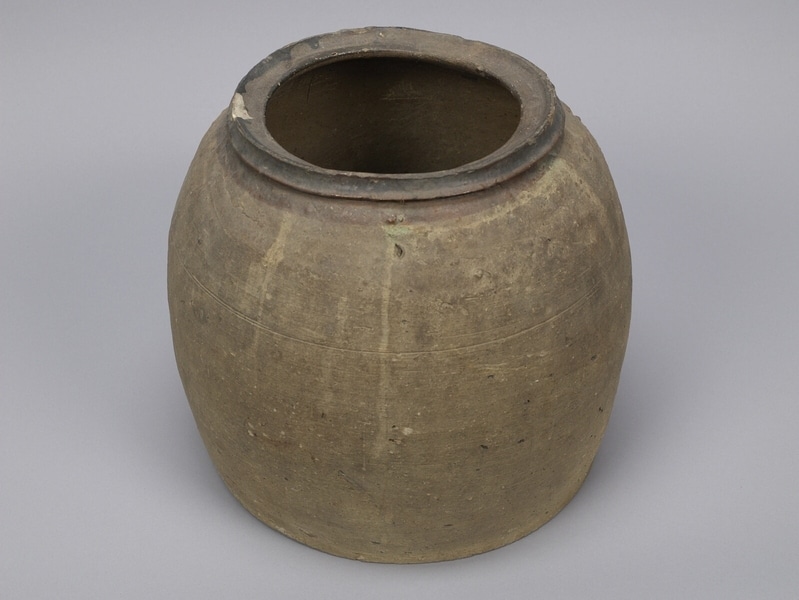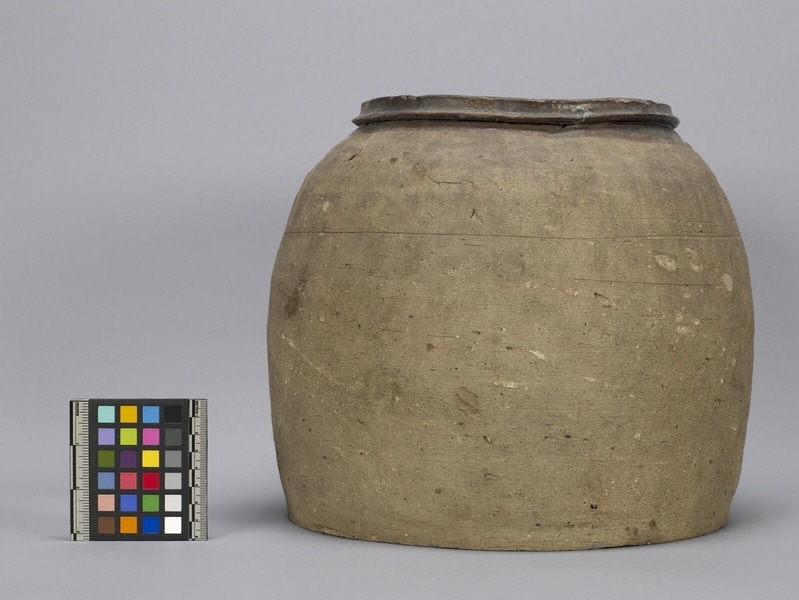Jar Item Number: Edz1052 from the MOA: University of British Columbia



Description
Rounded clay jar with a flat bottom and a raised lip; brown glaze around lip. Glazed on inside; outside is unglazed. Chip on edge of rim.
History Of Use
According to the donor, Mr. Chan Heng-Faat, these jars were used at New Year to hold special sweets called maaih tung. The sweets were very complicated to make, through a process that required puffing glutinous rice and then mixing it with peanuts and sugar syrup. If they were exposed to the air they would fall apart, so jars like this were necessary. They were sealed by putting a cloth over the top and then an inverted bowl. He said that every household had about 20 jars for this purpose. Later, tin boxes were used instead. The shape of this jar is the same as those used to hold ancestors’ bones after they have been disinterred, and the Chinese character of its name is the same as one of the two characters designating those jars. After the mid-twentieth century the New Territories of Hong Kong began to undergo fundamental changes. The people who had been settled there before 1898, when the British colonizers claimed the area, began to give up rice agriculture and coastal fishing, turning instead to wage labour and increased employment overseas. By the end of the century, educational opportunities leading to the possibility of white-collar work also increased, together with western influences. These changes meant that objects and clothing once useful and appropriate were no longer needed and generally were discarded. Some were saved by their owners, who sometimes were willing to donate them to museums, sharing, also, their knowledge of how they were made and used. Almost certainly these traditional sweets are no longer made. People are now more affluent and can purchase sweets, which are readily available. They now often prefer those to the traditional ones.
Narrative
As Hong Kong’s New Territories modernized it was common for people to give up objects that were no longer useful and, as Mr. Chan stated, jars like this had been replaced by tin boxes. Hakka people are one of the two original land-dwelling groups that settled the area that became the New Territories of Hong Kong. Their spoken language, and some customs, differed from those of the other original group, the Cantonese or Punti. The Cantonese arrived first and settled on the best rice-growing lands, while the Hakka began to arrive after the late 17th century and settled the more hilly lands.
Item History
- Made in Tsuen Wan, Hong Kong, China
- Collected by Elizabeth L. Johnson during 1979
- Owned by Heng-faat Chan
- Owned by Elizabeth L. Johnson before March 17, 1980
- Received from Elizabeth L. Johnson (Seller) and Museum of Anthropology Shop Volunteers (Funding source) on March 17, 1980
What
Who
- Culture
- Chinese: Hakka
- Field Collector
- Elizabeth L. Johnson
- Previous Owner
- Heng-faat Chan and Elizabeth L. Johnson
- Received from
- Elizabeth L. Johnson (Seller) and Museum of Anthropology Shop Volunteers (Funding source)
Where
- Holding Institution
- MOA: University of British Columbia
- Made in
- Tsuen Wan, Hong Kong, China
When
- Collection Date
- during 1979
- Ownership Date
- before March 17, 1980
- Acquisition Date
- on March 17, 1980
Other
- Item Classes
- ceramics
- Condition
- fair
- Accession Number
- 0610/0022